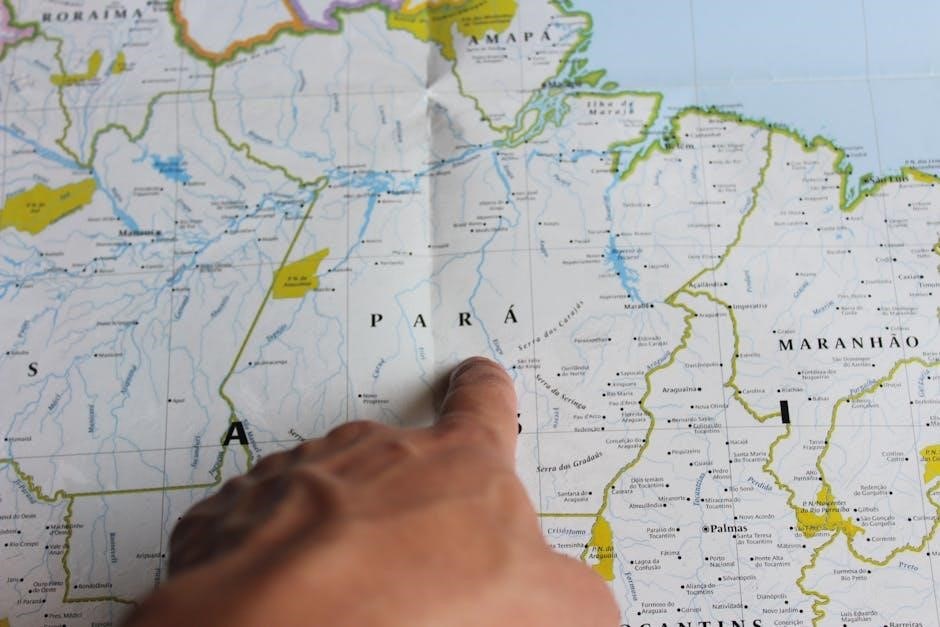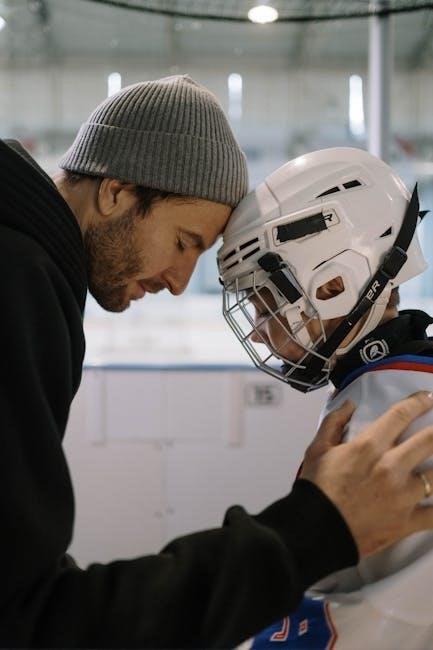This guide provides essential insights for parents to assess the suitability of the Atlas movie for their children, focusing on content, themes, and age-appropriateness.
1.1 Overview of the Movie’s Content
The Atlas movie, based on Ayn Rand’s novel, explores themes of philosophy, politics, and personal freedom. Rated PG-13, it contains mild sexual content, moderate profanity, and some violence. The story follows a powerful railroad executive navigating a society in crisis, blending drama with ideological debates. While suitable for older teens, parents should be cautious due to mature themes and brief suggestive scenes. The film’s complex narrative and moral dilemmas make it a thought-provoking experience, though not entirely appropriate for younger audiences without guidance;
1.2 Importance of a Parents Guide
A parents guide is crucial for helping guardians make informed decisions about their children’s media consumption. It provides detailed insights into content, themes, and age-appropriateness, ensuring parents can assess suitability based on their child’s sensitivity and maturity. For the Atlas movie, the guide highlights key elements like mild sexuality, violence, and moderate profanity, offering a clear understanding of what to expect. This resource empowers parents to navigate complex themes and decide whether the film aligns with their family’s values and standards, fostering a safer and more mindful viewing experience for younger audiences.

Motion Picture Rating (MPA)
The movie is rated PG-13 for some violence and a scene of sexuality, ensuring guidance for viewers under 13 due to mature content.
2.1 PG-13 Rating Explanation
The PG-13 rating indicates that the movie contains material that may be inappropriate for children under 13. This rating suggests moderate content, including violence, brief sexuality, or suggestive themes, requiring parental guidance. For Atlas, the PG-13 rating reflects scenes of mild violence and some sensuality, making it suitable for teens but cautioning younger viewers. Parents should review the content to ensure it aligns with their child’s maturity level and sensitivity to such themes.
2.2 Reasons for the PG-13 Rating
The Atlas movie received a PG-13 rating primarily due to brief sexual content, including a scene of sensuality and mild nudity. Additionally, there are instances of moderate profanity and some violence, though not excessively graphic. These elements, while not overly explicit, are deemed inappropriate for younger audiences without parental guidance. The rating reflects a balance between mature themes and overall restraint, ensuring the film is accessible to teens but with caution advised for younger viewers.

Sex and Nudity in the Movie
The film contains mild sexual content, including a scene with a woman in a low-cut negligee, briefly revealing cleavage and nipples, though not explicitly graphic.
3.1 Mild Sexual Content
The Atlas movie contains mild sexual content, including a scene where a woman is shown asleep in a low-cut negligee, revealing cleavage and bare shoulders, with nipples visible through the fabric. While not explicit, these moments may raise concerns for parents of younger or sensitive viewers. The content is brief and not overly graphic, but it does contribute to the film’s PG-13 rating. Parents should be aware of these scenes when deciding if the movie is suitable for their children.
3.2 Scenes of Sensuality
The movie includes subtle scenes of sensuality, such as a woman wearing a low-cut negligee, revealing cleavage and bare shoulders, with nipples visible through the fabric. These moments are brief but may raise concerns for some parents. The content is suggestive rather than explicit, yet it still warrants attention for younger audiences. The scenes are woven into the narrative to reflect character dynamics, but they could prompt discussions about appropriateness for children. Parents should consider their child’s sensitivity to such imagery when deciding suitability.
3.4 Nudity and Suggestive Imagery
The movie contains mild nudity, including a scene where a woman is shown wearing a low-cut negligee, revealing cleavage and bare shoulders, with nipples visible through the fabric. While not explicit, these moments may raise concerns for parents of younger or sensitive viewers. The imagery is suggestive but not graphic, aligning with the PG-13 rating. Parents should consider their child’s maturity level when deciding if this content is appropriate.

Violence and Gore
The movie contains mild violent scenes, including action sequences and brief intense moments, but avoids excessive gore, making it suitable for older children with parental discretion.
4.1 Mild Violent Scenes
The Atlas movie contains mild violent scenes, including brief scuffles and action sequences. These moments are not overly graphic or prolonged, making them suitable for older children and teenagers. While the violence is minimal, parents should be aware of the context and intensity to ensure it aligns with their child’s sensitivity levels; The film’s action scenes are designed to advance the plot rather than focus on gratuitous violence, providing a balanced viewing experience for young audiences.
4.2 Intensity of Action Sequences
The Atlas movie features action sequences that are suspenseful and engaging, with moments of dramatic tension. While not excessively graphic, these scenes may be intense for younger viewers, especially those sensitive to conflict or peril. Parents should consider their child’s ability to distinguish fiction from reality and handle thrilling moments without distress. The action is balanced with the film’s philosophical themes, making it suitable for older children and teenagers who can grasp the narrative’s depth. This section helps parents evaluate whether the movie’s action elements align with their child’s maturity level and sensitivity to such content.

Profanity and Language
The film contains moderate profanity, used in specific contexts, which parents should consider when deciding suitability for younger audiences, though it’s not excessively explicit.
5.1 Moderate Use of Profanity
The Atlas movie contains moderate profanity, with occasional use of common swear words and mild expletives. While not excessive, the language is present in dialogue, often during tense or emotional scenes. The profanity is not gratuitous but serves to reflect character emotions or stress. Parents should be aware that younger or sensitive children may find some phrases objectionable. The overall use of profanity is not pervasive but noticeable enough to warrant consideration for younger audiences. This aspect, combined with other content elements, contributes to the PG-13 rating and parental discretion being advised.
5.2 Context of Language Usage
The moderate profanity in Atlas is used selectively, often reflecting character emotions or tense situations. While not excessive, it includes terms that may require parental discretion. The language aligns with the film’s mature themes, emphasizing dialogue that drives character development and plot progression. Parents should be aware of occasional strong words, particularly in scenes involving conflict or stress. However, the overall use of profanity remains restrained, fitting the PG-13 rating. This context helps parents gauge whether the language is appropriate for their child’s sensitivity level.
Alcohol, Drugs, and Smoking
The movie depicts moderate alcohol consumption and occasional smoking scenes, though neither is pervasive. Parental discretion is advised due to these elements.
6.1 Presence of Alcohol Consumption
The Atlas movie includes scenes where alcohol consumption is depicted, often in social or professional settings. These moments are not excessive but reflect character interactions and plot development. While the portrayal is not glorified, parents should be aware of the presence of alcohol in certain contexts. The scenes are generally mild and not central to the storyline, but they may warrant discussion with younger viewers about responsible behavior. The film’s PG-13 rating acknowledges these elements, though they are not overly emphasized. Parents can use this as a point to address alcohol-related topics with their children.
6.2 Depiction of Smoking
Smoking is not a prominent feature in the Atlas movie, but brief scenes may depict characters smoking, reflecting the time period and character traits. These moments are not extensive or glorified, and their impact is minimal compared to other themes. Parents should be aware of these depictions, especially if their children are sensitive to such imagery. The film’s focus remains on philosophical and political themes rather than lifestyle choices, making smoking a secondary element. This aspect, combined with the PG-13 rating, suggests moderate caution for younger audiences.
Frightening and Intense Scenes
The movie contains suspenseful moments and emotional intensity that may unsettle younger viewers, with scenes that could provoke anxiety or distress in sensitive audiences.
7.1 Scenes That May Disturb Younger Audiences
The Atlas movie contains some intense sequences, including a dramatic train crash and its aftermath, which may unsettle younger viewers. Emotional tension and philosophical conflicts could also be overwhelming for sensitive children. Parents should be cautious, as these scenes might provoke anxiety or discomfort in younger audiences due to their dramatic and thought-provoking nature.
7.2 Emotional Intensity in the Movie
The Atlas movie explores complex themes like individualism and societal conflict, which may evoke strong emotions in viewers. Scenes depicting moral dilemmas and philosophical debates can be intense, especially for younger audiences. The film’s emotional depth, including moments of tension and character struggles, may resonate deeply with teenagers. Parents should be aware of the movie’s ability to provoke thought and emotional responses, particularly in sensitive or impressionable children. This aspect of the film can spark meaningful discussions but may also require guidance to help younger viewers process the content effectively.

Themes and Messages
The movie explores philosophical themes, political commentary, and moral dilemmas, offering a thought-provoking narrative that encourages reflection on individualism and societal structures.
8.1 Philosophical Themes
The Atlas movie explores deep philosophical ideas, particularly objectivism and individualism, reflecting Ayn Rand’s original novel. Themes of self-reliance, innovation, and the role of government in society are central. The film prompts viewers to consider the balance between personal freedom and collective responsibility, encouraging critical thinking about ethical and moral dilemmas. These concepts are presented through characters’ choices and societal conflicts, making the movie a catalyst for discussions on liberty, entrepreneurship, and the human spirit. Parents should be prepared to address these complex ideas with their children, as they form the core of the narrative and its message.
8.2 Political and Social Commentary
The Atlas movie incorporates themes of political and social commentary, reflecting Ayn Rand’s philosophical views on individualism and government control. The story critiques excessive bureaucratic interference and celebrates entrepreneurial spirit. These elements encourage critical thinking about societal structures and personal freedom. Parents should be aware that the film’s ideological stance may spark discussions about capitalism, self-reliance, and the role of government. While these themes are central to the narrative, they are presented in a way that aligns with the PG-13 rating, making them accessible for older teens and adults. This commentary adds depth to the storyline, offering food for thought for mature audiences.
8.3 Moral and Ethical Dilemmas
The Atlas movie explores complex moral and ethical dilemmas, prompting viewers to reflect on individualism, sacrifice, and societal responsibility. Characters often face tough choices that challenge their beliefs and values.
These dilemmas, rooted in the story’s philosophical themes, encourage critical thinking about right and wrong. Parents should be prepared to discuss these concepts with their children, as they may spark questions about ethics and decision-making.

Positive Role Models and Lessons
9.1 Strong Female Lead Characters
The movie features strong, independent female characters who embody resilience and intelligence, offering positive role models for young audiences.
9.2 Themes of Perseverance and Determination
Central themes emphasize determination and self-reliance, encouraging viewers to embrace challenges and strive for personal growth.
The Atlas movie features strong female lead characters who embody independence and resilience. Dagny Taggart, a central figure, is portrayed as a determined and visionary railroad executive. Her character showcases leadership and a steadfast commitment to her goals, even in the face of adversity. These traits make her a compelling role model, highlighting the importance of perseverance and self-reliance. The film’s depiction of women in powerful roles offers a positive message for young viewers, particularly girls, by illustrating the potential for women to thrive in traditionally male-dominated industries. This aspect of the movie is a significant point for parents to consider.
The Atlas movie highlights themes of perseverance and determination, showcasing characters who face significant challenges yet remain steadfast in their convictions. These elements inspire resilience and emphasize the importance of standing firm against adversity, making it a valuable lesson for young audiences.
The film’s strong narrative encourages viewers to reflect on the power of unwavering resolve, offering a positive message about overcoming obstacles and staying committed to one’s principles, even in the face of daunting opposition.

Negative Role Models and Behaviors
The film portrays manipulative characters and morally ambiguous decisions, which may influence younger viewers, prompting parents to exercise discretion and discuss ethical implications with their children.
10.1 Manipulative Characters
The Atlas movie features characters who exhibit manipulative behaviors, often influencing others for personal gain or control. These characters use charm, deceit, or emotional tactics to achieve their goals, which can be unsettling for younger audiences. Their actions create moral dilemmas and complex relationships, making it essential for parents to discuss these behaviors with their children. The manipulative nature of these characters adds depth to the story but may require guidance to help younger viewers understand the implications of such actions and their real-world consequences.
10.2 Ethical Ambiguity in Decision-Making
The movie explores complex moral choices, often blurring the line between right and wrong. Characters face dilemmas that challenge conventional ethics, prompting viewers to question their own values.
Parents should be prepared to discuss how the film’s themes of individualism and sacrifice might influence younger audiences’ understanding of morality and decision-making.

Family Content and Suitability
The movie is suitable for older audiences, with parental discretion advised for mature themes. Not ideal for young children, sensitivity recommended for teenagers due to content.
11.1 Caution Advised for Older Children
Parents should exercise caution when allowing older children to watch Atlas, as the film contains mature themes, mild violence, and some suggestive content. While not excessively graphic, scenes involving philosophical debates and political commentary may be challenging for younger audiences to process. The movie’s emotional intensity and moral dilemmas could also be unsettling for sensitive viewers. Parental discretion is advised to ensure children are emotionally prepared for the film’s complex narrative and occasional intense moments;
11.2 Sensitivity for Teenagers
The Atlas movie contains themes and scenes that may require sensitivity for teenagers. While the PG-13 rating suggests suitability for teens, parents should be aware of mild sexual content, moderate violence, and philosophical themes that might spark complex discussions. The film’s focus on ethical dilemmas and political commentary could be challenging for younger audiences to process. However, the strong female lead and themes of perseverance offer positive role models. Parents are advised to preview the content or watch alongside their teens to address any questions or concerns about the movie’s mature elements and ensure it aligns with their child’s sensitivity level.

Entertainment Quality and Engagement
The movie offers a blend of visual effects, engaging storytelling, and character depth, maintaining audience interest and leaving a lasting impression.
12.1 Cinematic Appeal
The Atlas movie offers a compelling blend of engaging storytelling and thought-provoking themes, making it cinematically appealing for audiences who enjoy both entertainment and intellectual stimulation. With strong character development and a narrative that explores complex ideas, the film captivates viewers seeking depth in their cinematic experiences. Its ability to balance action with philosophical dialogue enhances its appeal, attracting fans of dystopian and futuristic genres. The movie’s visual and auditory elements further contribute to its immersive quality, ensuring an engaging experience for those drawn to stories that challenge and inspire.
12.2 Audience Engagement Factors
The Atlas movie captivates audiences with its blend of philosophical themes and dynamic storytelling, making it engaging for viewers who appreciate intellectual narratives. The strong female lead and moral dilemmas encourage reflection, while the film’s pacing balances action and dialogue effectively. Fans of Ayn Rand’s work may find it particularly appealing due to its faithful adaptation of complex ideas. The movie’s ability to spark discussions about freedom and ethics adds to its appeal, making it a thought-provoking experience for mature audiences.
Parents should use discretion due to mild content. The PG-13 rating suggests suitability for mature teens, balancing thoughtful themes with caution for younger audiences.
13.1 Final Thoughts for Parents
Parents should exercise discretion when allowing children to watch Atlas, considering its mature themes, mild sexual content, and moderate profanity. While the film offers philosophical insights, its complexity may not suit younger audiences. Teenagers, especially those mature enough to grasp political and ethical discussions, may benefit from the movie’s thought-provoking narrative. However, sensitive or younger viewers might find certain scenes unsettling; Ultimately, parental guidance is recommended to ensure the content aligns with individual family values and standards.
13.2 Recommendations Based on the Guide
Parents are advised to exercise discretion, as the film contains mild sexual content, moderate profanity, and some violence. It is suitable for mature teenagers but may require guidance for younger audiences. The movie’s philosophical themes and complex moral dilemmas offer opportunities for meaningful discussions. Viewer sensitivity to intense scenes should be considered. Overall, the film is engaging but warrants parental oversight to ensure it aligns with family values and viewing standards.
